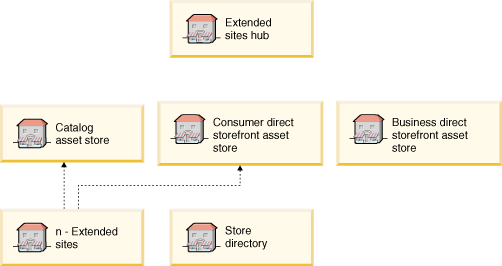Customer-facing stores
Customer-facing stores are stores that provide a Web storefront that customers can access directly. These stores are the main components of your site.
For direct sales (whether B2C or B2B) stores or hub sites, you must create storefront assets, business logic and store data for each store. These assets can be created traditionally, by creating the assets for that store only, or by creating the assets to be used by other stores. This is done by creating the storefront and business logic assets either in an asset store or as data that can be used across stores. You may also want to use assets from other stores to create portions of your direct sales (whether B2C or B2B) stores or hub sites.
 In the samples provided with HCL Commerce, the majority of the
extended sites are created by sharing assets from existing asset stores. For example, rather than
creating the storefront or catalog assets for each store, you use the storefront and, depending on
your business, the catalog from another store. In order to facilitate creating stores, HCL Commerce uses asset stores. The following diagram illustrates how stores use the assets from
the storefront asset store and the catalog asset store. The storefront asset store can be either a
B2C or B2B store and resellers select the store type when they create a store.
In the samples provided with HCL Commerce, the majority of the
extended sites are created by sharing assets from existing asset stores. For example, rather than
creating the storefront or catalog assets for each store, you use the storefront and, depending on
your business, the catalog from another store. In order to facilitate creating stores, HCL Commerce uses asset stores. The following diagram illustrates how stores use the assets from
the storefront asset store and the catalog asset store. The storefront asset store can be either a
B2C or B2B store and resellers select the store type when they create a store.


Your store business administrators then have the option of making cosmetic changes (such as a new look and feel, their own new logo and some of their own text) to customize their store, as well as changing certain data (filtering the catalog, changing prices and so on).
You can also create stores traditionally, that is by creating the storefront assets, business logic, and store data separately for each store.